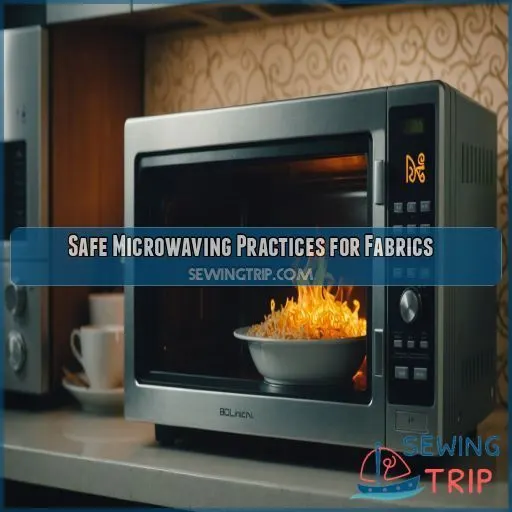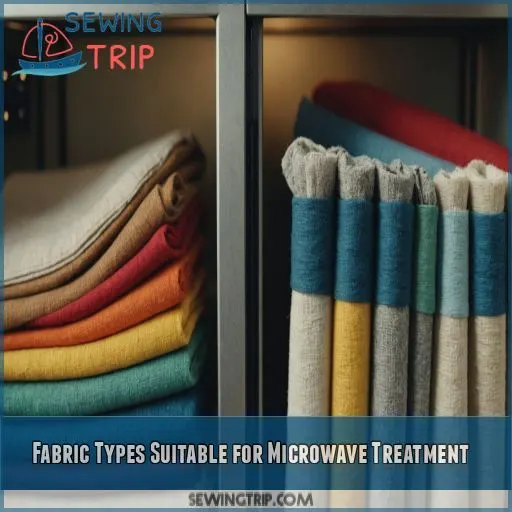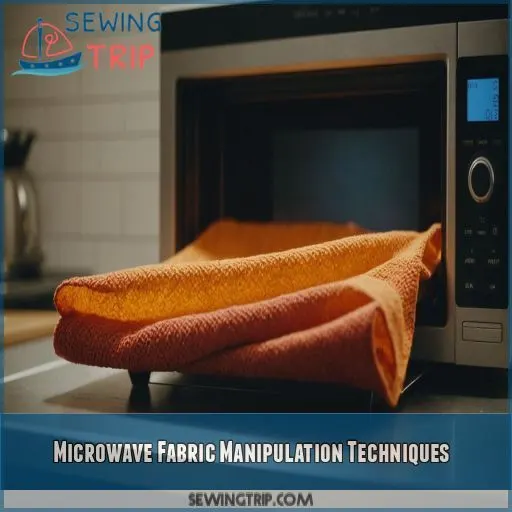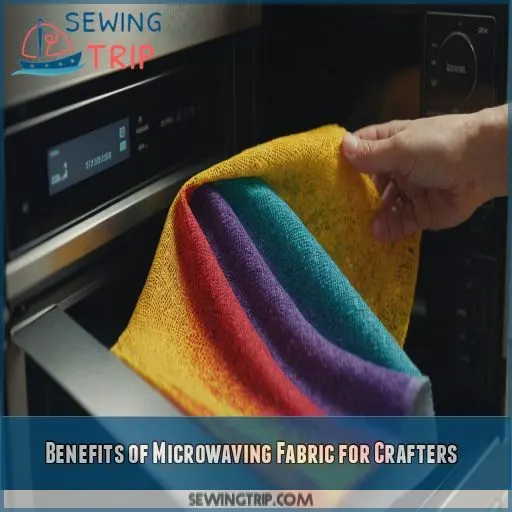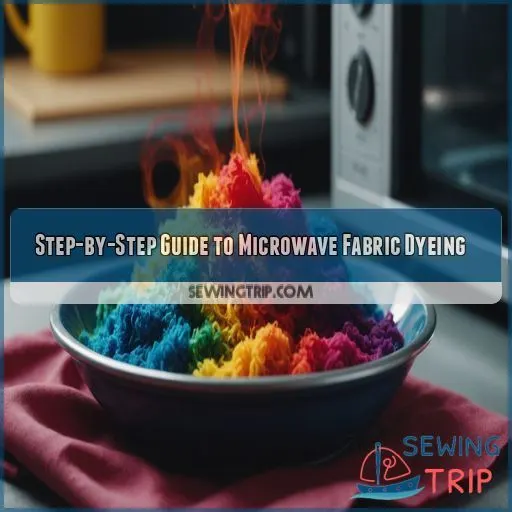This site is supported by our readers. We may earn a commission, at no cost to you, if you purchase through links.
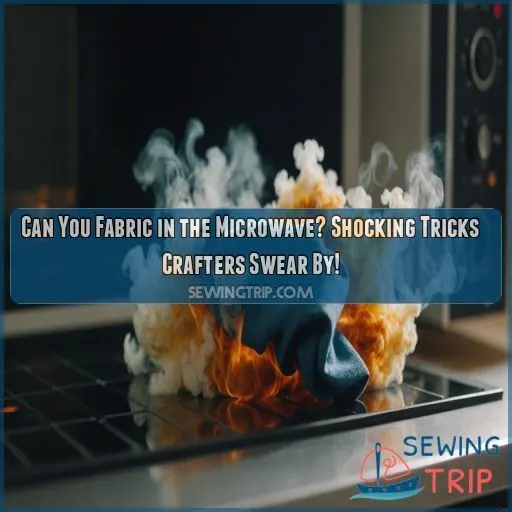
When done right, microwaving fabric can be a game-changer for crafters, offering precision control over heat application and unique creative possibilities.
So, if you’re ready to learn about microwave fabric manipulation, you’re in for a treat – and a few surprising tricks up your sleeve!
Stick to natural fibers like cotton and linen, and avoid synthetic fibers like polyester and nylon.
Don’t even think about using metallic threads or fabrics with metallic bits – that’s just asking for trouble.
Table Of Contents
- Key Takeaways
- Safe Microwaving Practices for Fabrics
- Fabric Types Suitable for Microwave Treatment
- Microwave Fabric Manipulation Techniques
- Benefits of Microwaving Fabric for Crafters
- Step-by-Step Guide to Microwave Fabric Dyeing
- Potential Risks and Safety Precautions
- Frequently Asked Questions (FAQs)
- Conclusion
Key Takeaways
- You’ll want to stick to Natural Fibers like cotton and linen when microwaving fabric, and avoid synthetic fibers like polyester and nylon – unless you’re working with a polyester blend that’s under 35% polyester content.
- To avoid turning your crafting session into a mini disaster movie, steer clear of flammable materials like acetate, moisture-sensitive fabrics like silk, and metallic threads or fabrics with metallic bits.
- When microwaving fabric, it’s crucial to monitor the process closely, checking every 30 seconds for signs of trouble like smoke or odd smells, and adjusting the power level and time as needed to achieve the desired effect.
- By mastering the art of microwave fabric manipulation, you’ll unlock a world of creative possibilities, from creating permanent crinkled effects to setting precise pleats, and even achieving vibrant dye results with microwave dyeing methods – just remember to follow the safety guidelines and take necessary precautions to avoid damage or injury.
Safe Microwaving Practices for Fabrics
You might think tossing fabric in the microwave is a recipe for disaster, but with the right know-how, it’s actually a game-changer for crafters. Before you zap that scrap of cotton, though, let’s go over some essential safety tips to keep your DIY dreams from going up in flames (literally).
Heat-Resistant Materials and Containers
Ready to zap your fabric? Hold your horses! You’ll need the right tools for this microwave rodeo.
Stick with microwave-safe containers. Glass is your new best friend.
Plastic can work too, but make sure it’s up to the task.
Silicone alternatives are like the Swiss Army knife of microwave crafting.
And don’t forget ceramic options – they’re tough as nails.
Your fabric’s about to get a heat makeover!
Avoiding Flammable or Moisture-Sensitive Fabrics
You wouldn’t microwave a marshmallow, right? Well, some fabrics are just as risky.
Steer clear of flammable materials like acetate or moisture-sensitive ones like silk.
These fabrics can turn your crafting session into a mini disaster movie.
Stick to cotton, linen, and polyester blends under 35% to keep your microwave (and your project) safe and sound.
Monitoring the Microwaving Process
Microwaving fabric is not a "set it and forget it" deal.
Keep your eyes peeled for any signs of trouble, like smoke or odd smells.
Time flies in the microwave, so check every 30 seconds.
It’s like watching a pot boil, but way more exciting!
You’re the master of your fabric’s destiny, so stay alert and in control.
Recommended Microwave Settings for Fabrics
Now that you’re keeping a close eye on your fabric, let’s talk settings. Getting the right power level and time is really important for success. Here’s a quick cheat sheet for your microwave adventures:
- Start with 50% power for delicate fabrics
- Use 30-second bursts for most projects
- Increase power gradually for thicker materials
- Rotate fabric halfway through for even heating
- Always err on the side of caution – you can’t "uncook" your creation!
Fabric Types Suitable for Microwave Treatment
You might be surprised to learn that your microwave isn’t just for reheating leftovers—it’s also a secret weapon for Fabric Manipulation. Before you start zapping your entire wardrobe, let’s explore which fabrics play nice with microwaves and which ones are best left in the closet.
Cotton and Linen
Ready to zap your fabrics? Cotton and linen are your microwave’s best friends! These natural fibers can take the heat, making them perfect for your crafty experiments. Check out this handy guide to see what magic you can work:
| Technique | Cotton | Linen |
|---|---|---|
| Shrinkage | High | Low |
| Dyeing | Easy | Tricky |
| Wrinkles | Prone | Resistant |
| Natural Dyes | Absorbs well | Takes beautifully |
Polyester Blends (Under 35% Polyester Content)
Moving on from cotton and linen, let’s talk polyester blends.
You’re in luck if your fabric is less than 35% polyester!
These blends can handle the microwave’s heat, opening up a world of possibilities.
Want to add some pizzazz to your polyester blend shirt? Try microwaving it for a quick texture change.
Just remember, the higher the polyester content, the more cautious you’ll need to be.
Stick to the 35% rule for best results!
Nylon (Non-Sheer Varieties)
You might be surprised, but certain nylon fabrics can handle the microwave heat!
Non-sheer varieties are your best bet.
They’re like the tough guys of the synthetic world, ready to take on your creative projects.
Just remember, not all nylons are created equal.
When in doubt, do a quick test run with a small swatch.
You’ll be amazed at the vibrant dye results you can achieve!
Fabrics to Avoid in the Microwave
While microwaving fabric can be a game-changer, some materials are a big no-no. You’ll want to steer clear of these troublemakers:
- Rayon: It’s like a diva in the microwave – unpredictable and prone to meltdowns.
- Wool: Unless you’re aiming for a shrunken sweater, keep it out!
- Acetate and synthetics: They’re not built for the heat, folks.
- Moisture-sensitive fabrics: They’ll throw a fit in there.
Microwave Fabric Manipulation Techniques
You’re about to discover some mind-blowing fabric manipulation techniques using your trusty microwave. From creating permanent crinkles to setting precise pleats, these microwave tricks will revolutionize your crafting game and open up a world of textile possibilities right in your kitchen.
Creating Permanent Crinkled Effects
Want to give your fabric a unique, crinkled look that’ll turn heads?
Microwaving might be your secret weapon!
Jenny S., a crafting whiz, discovered this game-changing technique for polyester velvet.
Here’s the scoop: wet your fabric, tie it in bundles, and zap it in short bursts.
Voila! You’ve got yourself a permanent crinkle effect that’ll make your projects pop.
Just remember, not all fabrics play nice with microwaves!
Setting Creases and Pleats
Time to get crisp and sharp! Using your microwave, you can set creases and pleats in fabrics like cotton and linen. Simply dampen the fabric, fold it into the desired shape, and heat it in short bursts until the crease is set. The result is a durable, long-lasting pleat that will elevate your sewing projects to the next level.
Altering Fabric Textures
Now that you’ve mastered setting creases and pleats, it’s time to experiment with altering fabric textures! By microwaving fabric in short bursts, you can create unique crinkled effects, similar to Jenny S.’s polyester velvet technique. Try wetting, tying, and microwaving fabric to achieve fascinating texture variations. The possibilities are endless, and it’s a game-changer for fabric experimentation!
Microwave Dyeing Methods
Get ready to revolutionize your fabric dyeing game!
With microwave dyeing methods, you can achieve vibrant colors and unique effects.
Mix your dye bath to the perfect temperature, wrap your fabric, and zap it for 1-2 minutes.
Watch for color variations, fabric shrinkage, and don’t forget to add a dye fixative for long-lasting results.
Who knew microwaving could be so… colorful?
Benefits of Microwaving Fabric for Crafters
You’re about to discover the secret benefits of microwaving fabric that crafters swear by – from convenience and accessibility to precise control over heat application. With microwaving, you’ll save time compared to traditional methods and open up unique creative possibilities that’ll take your crafting game to the next level.
Convenience and Accessibility
The convenience of microwaving fabric! You can achieve professional-looking results without breaking the bank or spending hours in a studio. With a microwave, you can experiment with fabric alterations in the comfort of your own home, saving time and money. It’s a game-changer for crafters on a budget or with limited space, making textile crafting a breeze.
Precise Control Over Heat Application
Now that we’ve covered convenience and accessibility, let’s talk precision! With microwaving, you have total control over heat application. By adjusting temperature zones, microwave power levels, and time intervals, you can achieve consistent results. This is especially important when working with heat-sensitive fabrics. Mastering heat distribution is key to achieving unique textures and effects.
Time-Saving Compared to Traditional Methods
If you’re a crafter who loves speed and efficiency, microwaving is a game-changer when it comes to fabric manipulation. By using your microwave, you can achieve faster results, reduced drying time, and effortless wrinkle removal. Here are three ways microwaving saves you time:
- Reduced dyeing time: Microwave dyeing cuts the dyeing process down to mere minutes.
- Faster steaming: Steaming fabric in the microwave removes wrinkles in a flash.
- Quick drying: Microwaving fabric reduces drying time, so you can get on with your project sooner.
Unique Creative Possibilities
Get ready to explore your creativity! Microwave-dyeing techniques open doors to unique fabric art projects. Experiment with texture experimentation, heat-activated dyes, and shibori-inspired patterns. Imagine creating one-of-a-kind designs that showcase your mastery. With microwave dyeing, the possibilities are endless. So, don’t be afraid to push boundaries and try new things – your fabric will thank you!
Step-by-Step Guide to Microwave Fabric Dyeing
You’re about to discover the magic of microwave fabric dyeing, a game-changing technique that’s quick, easy, and ridiculously fun. With just a few simple steps, you can transform plain fabrics into vibrant, one-of-a-kind masterpieces that’ll make your friends green with envy (or should we say, dye with envy!).
Preparing the Dye Bath
You’re ready to create your dye bath! To get started, you’ll need to mix the perfect blend of dye, water, and magic (just kidding, it’s science!). Here are the key things to keep in mind:
- Dye bath temperature: not too hot, not too cold
- Dye concentration: just the right amount of color
- Water volume: enough to cover your fabric
- Dye fixative: the secret to making it last
Fabric Preparation and Pre-Treatment
Get your fabric ready for its microwave debut! Before dyeing, pre-wash your fabric in warm water with a mild detergent to remove any finishes that might interfere with the dye. Don’t forget to test a small swatch for colorfastness and dye compatibility. And, yes, ditch the fabric softener – it’s a dye-killer! Your fabric will thank you.
Microwave Dyeing Process
Now it’s time to get your microwave dyeing process underway. Here’s what you need to do:
- Cover the container with plastic wrap to prevent splatters.
- Protect the microwave bottom with paper towels or newspaper.
- Microwave on high for up to two minutes, monitoring the process closely.
- Remove the container carefully to avoid burns.
- Let it cool before proceeding to the next step.
Rinsing and Fixing the Dye
After microwaving, carefully remove the container and let it cool. Rinse the fabric under cold running water to stop the dyeing process. To prevent dye bleeding, use a color fixative like Rit ColorStay. A cold water rinse helps achieve colorfastness. Gently squeeze out excess water, but don’t wring or twist the fabric.
Post-Dyeing Care and Washing
Now that you’ve rinsed and fixed the dye, it’s time to give your newly colored fabric some TLC.
To prevent dye bleeding and make sure the color stays put, wash it in warm water with a mild detergent.
Avoid wringing or twisting the fabric.
Consider air-drying or tumble-drying on a low setting to minimize fabric shrinkage.
Choose a gentle detergent, and you’re all set!
Potential Risks and Safety Precautions
When you’re thinking about microwaving fabric, it’s important to be aware of the potential dangers. From fire hazards and flammable materials to overheating and fabric damage, there are things to keep in mind. If you take the right safety precautions, you can have fun creating with microwaved fabric while staying safe and protecting your workspace.
Fire Hazards and Flammable Materials
Now that you’ve mastered the art of microwave fabric dyeing, let’s talk safety.
Flammable fabrics are a major no-go for microwaving.
Avoid using fabrics like silk, wool, or anything with metallic threads.
These can ignite quickly, causing a fire hazard.
Stick to cotton, linen, or synthetic blends, and always follow fire prevention guidelines to make sure you have a safe microwaving experience.
Overheating and Fabric Damage
Now that we’ve covered fire hazards, let’s talk about overheating and fabric damage. To avoid scorching your fabric, master temperature control by adjusting microwave power levels and considering fabric thickness. Be cautious with heat-sensitive fabrics, and have a plan for repairing damaged fabric. Remember, a little patience and caution can go a long way in preventing damage.
Chemical Safety When Dyeing
When dyeing fabric in the microwave, your safety is paramount. As you mix and heat those colorful chemicals, you’ll want to take precautions to avoid skin contact and exposure. Don’t let your creative zeal cloud your judgment – take a few simple steps to protect yourself from potential hazards.
- Use rubber or plastic gloves to prevent skin irritation and stains
- Avoid breathing in dye dust – it’s no joke for your lungs
- Wear old clothes and an apron to safeguard your favorite garments
- Dispose of leftover dye and chemicals responsibly – the Earth will thank you
- Keep children and pets away from the dyeing area – it’s not a playground
Proper Ventilation and Workspace Protection
Now that we’ve covered chemical safety, let’s talk about keeping your workspace safe and well-ventilated. When dyeing, make sure you’re in a room with good airflow to prevent inhaling those pesky fumes. Open windows, use fans, and cover your work surface with newspaper or a plastic tablecloth to prevent spills and stains. Your lungs (and furniture) will thank you!
Frequently Asked Questions (FAQs)
Is it safe to put fabric in the microwave?
You’re wondering if it’s safe to put fabric in the microwave. Generally, it’s a no-go, but some natural fibers like cotton, linen, and hemp are okay in short bursts (Source). Always check the fabric’s label and follow safety guidelines.
Can you put a cloth in the microwave?
Like a master chef carefully heating a sauce, you can safely microwave a cloth, but only if it’s made of heat-resistant materials, avoiding flammable or moisture-sensitive fabrics, and following strict guidelines to prevent damage or fires.
Can you put material in a microwave?
You can put some materials in a microwave, but proceed with caution! Only use heat-resistant, microwave-safe fabrics like cotton or linen, and follow a reliable guide to avoid accidents and achieve the desired results.
Can polyester go in a microwave?
You’re wondering if polyester can go in the microwave? Be cautious, as microwaving polyester can be tricky. While some users have successfully crinkled polyester velvet, you should test a small area first to avoid damage or melting.
Can microwaving fabric damage my microwave oven over time?
Microwaving fabric regularly can potentially damage your oven over time, especially if you’re not careful. To minimize risks, always use microwave-safe containers, monitor the process closely, and clean up thoroughly to avoid any residue buildup.
How does microwaving affect the durability of treated fabrics?
You’re the master chef of fabric manipulation! Microwaving can be a recipe for success, but it may affect the durability of treated fabrics, making them more prone to wrinkles, fading, or snags – so handle with care!
Can I use microwaving to remove wrinkles from fabrics?
You can use microwaving to remove wrinkles from fabrics, but be cautious! Dampen the fabric, cover it with a microwave-safe cloth, and heat for 10-15 seconds. Check and repeat if needed, but avoid overheating or scorching.
Is it possible to create ombre effects using microwaving?
You’re in luck! Creating ombre effects using microwaving is a clever hack. By carefully controlling heat and dye, you can achieve a gorgeous gradient effect on your fabric. Just remember to test and tweak for the best results.
Can I microwave fabric with beads or sequins attached?
Sorry, no sparkles in the microwave, please! Avoid microwaving fabric with beads or sequins attached, as they can melt, warp, or even catch fire. Instead, use alternative embellishment methods or carefully remove them before microwaving.
Conclusion
When in doubt, test it out" – a wise adage for crafters experimenting with microwave fabric manipulation.
You’ve now learned the ins and outs of safely microwaving fabric, from heat-resistant materials to monitoring the process.
By following these guidelines, you can open up a world of creative possibilities.
So, can you fabric in the microwave? Absolutely!
With caution and practice, you’ll be crinkling, dyeing, and texturizing like a pro in no time.

